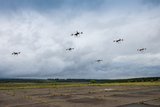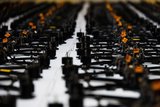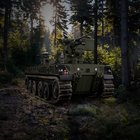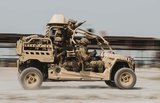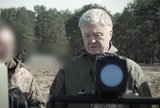London Science Museum Explores What Affects the Air We Breathe in a Special Exhibit Featuring the Manta UAV
Beijing’s breath of fresh air opened at the prestigious Science Museum in South Kensington, London on August 22, 2008 and will entice and pose breath taking questions of visitors through October. The core of the Museum’s Antenna Gallery exhibit examines how we study the air we breathe and some of what affects it.
Though the study of the atmosphere is far from new, the exhibit features the current research studies of leading university scientists employing a novel, yet reliable tool – an unmanned aerial vehicle (UAV). For some, the scientist’s choice is the Manta UAV produced by Advanced Ceramics Research’s (ACR). Flown using autonomous computer control and laden with miniaturized atmospheric instruments, it robotically grabs air samples, measures solar reflectance and floating particulates that are both manufactured and from Mother Nature.
Of great interest to scientists is the study of the changes of airborne pollution and the affect on the air we breathe coming downwind from Beijing as the Chinese Government attempted to curtail pollution for the Olympic Summer Games held in 2008. The belching of industrial and transportation borne pollution has long been associated with environmental consequences and the rapid growth of the bustling Chinese nation has shown seemingly unbridled smog causing releases.
The Chinese government’s ability to curb the very causes of the air pollution for the duration of the games of the XXIX Olympiad has provided a unique opportunity to continue the autonomous air borne research using the Manta UAVs. The NSF funded Cheju Atmospheric Brown Cloud Plume-Monsoon Experiment (CAPMEX) began in early August taking essentially baseline samples and will continue into September and post-Olympic Games to glean atmospheric data from several downwind locations in South Korea.
The state of California is also funding an ongoing research study, California Air Pollution Profiling Study over the skies of NASA Dryden Flight Research Center at Edwards Air Force Base (AFB), CA. The ongoing series of flight that began in April 2008 will collect data through January 2009. Flying the Manta UAVs in the restricted air space at Edwards AFB enables researchers to grab particulate samples as they are carried from hundreds of miles away.
The small UAV with Its tightly packed array of sensors offers scientists a robust and lower cost method to continue their atmospheric studies. First employed on atmospheric science missions in early 2006 for the Maldives AUAV Campaign (MAC) over the Indian Ocean under a funded research consortium including U.S. National Science Foundation , National Oceanic and Atmospheric Administration, NASA, and The G. Unger Vetlesen Foundation, it opened a unique chapter in both small UAV operations and scientific research.
In February 2006 an ACR flight operations team worked with MAC researchers to fly three Manta UAVs in a narrow, synchronized vertically stacked formation. The middle Manta flew through the cloud layer while the lower and upper ones were positioned below and above the cloud layer with approximately two miles of vertical separation between the aircraft. The tight UAV flight alignment enabled researchers to collect data between the Mantas during their average four hours of autonomous flights. The gathered data and analysis led to a compelling story aired on a NOVA program Dimming the Sun that detailed the affects of air borne particles on solar radiation. That research showed clear links to airborne particles carried by blowing winds affecting the very air we breathe regardless of our place on earth.
The world we live and breathe in depends on the winds powered by the sun that carry aloft bits of debris from societal activity. The range and types of interactions with their affects no longer remain just as curiosity. With the use of the lightweight, autonomous, lower cost Manta UAV researchers can uniquely collect data to better define them.
The Manta UAV was initially designed and prototyped in 2002 under a U.S. Naval Air Systems Command (NAVAIR) program. In 2003, the Defense Advanced Research Projects Agency (DARPA) and the Office of Naval Research (ONR) funded the first three production units for a research platform. The Manta UAV has a maximum gross take-off weight of 30kg with a 7kg payload, a 3m wingspan, and will fly for 4-6 hours. The Manta UAV is equipped for fully autonomous rolling take-offs and landings, or can be rail launched.








